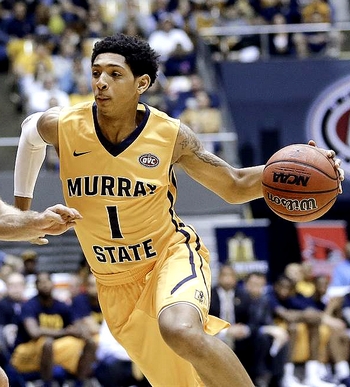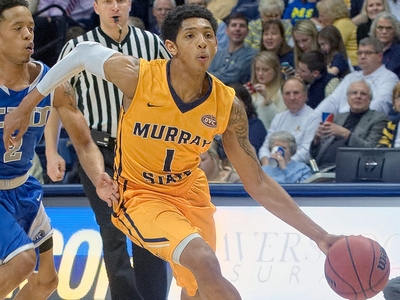Scouting Report by Jonathan Givony. Video Analysis by Mike Schmitz
A very skinny lefty from a small private school in suburban Memphis, Cameron Payne wasn't on the radar of any recruiting services back in high school. He came off the bench for the Bluff City Legends AAU team alongside six eventual high major players, shooting just 39% for 2 and 32% for 3 while playing just 15 minutes per game. That didn't stop him from becoming one of the most productive freshmen in college basketball, though, earning First-Team All-Ohio Valley Conference honors as well as Freshman of the Year. As a sophomore, he started to draw attention from the national media as well, as Murray State won 25 straight games while Payne was named OVC Player of the Year.
Murray lost in heartbreaking fashion in the conference tournament final to Belmont, and thus was relegated to the NIT, where they again lost on a buzzer beater (to Old Dominion) that prevented them from playing in the semifinals at Madison Square Garden. Payne elected not too long after to capitalize on his increasingly hot stock and enter the 2015 NBA Draft, where he is likely be anywhere from the third to fifth point guard selected depending on how private workouts shake out.
Payne has decent size for a NBA point guard at 6-2, although his 183 pound frame still needs to continue to fill out, which it will as he reaches physical maturity. Payne also has big hands and a very long wingspan (6-7) which helps him particularly on defense.
Payne biggest appeal as a NBA prospect is the terrific blend he displays between scoring and passing. He shouldered a huge amount of offense for Murray State (32% Usage, second highest in the DX Top-100), but still managed to remain relatively efficient (57% TS%) and dished out passes at a terrific rate (39.5% assist percentage, #1 in DX Top-100, 7.1 assists per-40, #4 DX-100).
He's an extremely unselfish player who passes with great creativity and loves to move the ball ahead in transition, either utilizing his excellent ball-handling skills or by finding the open man running the floor.
In the half-court, he changes speeds nicely and has a few different gears he can get to, which helps him in particular on the pick and roll, an area that made up nearly half of his overall offense. Payne sees the floor very well and utilizes all kinds of different types of passes, using both hands and sides of the court with outstanding timing and confidence. He stays very low on his drives, which, along with his ball-handling ability and variety of hesitation moves, helps compensate for the fact that he's not blessed with incredible blow-by speed or great strength.

Unlike many outstanding passers, Payne is also a capable outside shooter as well, hitting 2.5 threes per game as a sophomore and a similar number as a freshman. He doesn't have the most conventional mechanics, as his release point is somewhat low and he tends to contort his body sideways somewhat, but he shoots it the way same every time and gets his jumper off very quickly, which helps quite a bit.
While not a pure shooter, more than anything, Payne can be described as a shot-maker, as he often just wills the ball into the basket with tremendous touch and deep range, and is capable of getting very hot and knocking down a barrage of jumpers in a short span. When he's on-balance and shooting with good rhythm, he's very difficult to contain, which is a good sign for his future development, as many of his flaws as a jump-shooter can certainly be tweaked.
Payne can make shots in a variety of different ways, be it with his feet set, or off the dribble. He can come off screens, which Murray State asked him to do quite a bit of, and has a lot of options at his disposal once he catches the ball coming off a curl, as he'll often quickly find the open man to punish the help defense, can attack an aggressive closeout off the dribble, or will not hesitate to simply fire away if left open. He's also good at creating space with his terrific handle and pulling up in the mid-range area, which benefits him in the pick and roll game, and will help ease his transition to the NBA.
Payne's shooting touch really shines through with his ability to utilize floaters inside, and even outside the paint. He shot three floaters per game, more than any player in this draft class, and nevertheless hit them at a very good rate (47%). With that said, the volume of floaters he attempted tells us a little bit about his inability to drive all the way to the basket, which is somewhat of a red flag considering the level of competition he played at. This is not the most high percentage shot (0.962 PPP) because of how infrequently players get fouled in the act of releasing a floater, and shooting less than two shots per game at the rim in the half-court is certainly not ideal.
Payne is not a great finisher inside the paint overall, hitting just 49% of his attempts in both the half-court and in transitionfairly mediocre rates. While he handles the ball on a string, gets low to the ground and operates at many different speeds, he's not blessed with great pure explosiveness like many point guards in today's NBA, which makes it difficult for him to shed his man at times and find a clean path to the rim. His lack of strength surely didn't help in this area, as did his propensity for avoiding his off hand, but he has a difficult time finishing through contact and didn't get to the free throw line at a great rate. These were all issues for him playing at Ohio Valley Conference level, with nothing resembling the type of long and athletic rim-protecting big men he'll see in the NBA, so the question NBA teams will ask is how he will fare when the competition stiffens and he's forced to adjust his game.
Defensively, Payne is somewhat of a mixed bag. On one hand, his long arms, big hands and tremendous anticipation skills make him a terror in the passing lanes (2.1 steals per-40), and he even comes up with a good amount of steals (0.6 per-40, 2nd best among DX-100 PGs), showing just how advanced his timing and feel for the game is. He moves his feet well with nice lateral quickness, and can put good pressure on the ball when he's fully engaged, which gives him a great framework of skills on this end of the floor to improve on as he makes the transition to the NBA.
That didn't always translate to great results at the college level, though. While Murray State was an offensive juggernaut with Payne at the helm (#13 in efficiency according to KenPom), they were equally bad defensively, ranking #174 in that category. Payne certainly played a role in that, as he often lost his focus on that end of the floor and didn't display the highest intensity level, which makes sense to a degree considering how much he was counted on offensively.
Payne was often caught standing straight up on defense, or hunched over in his stance. He got posted up a fair amount due to his slight frame, and had a difficult time not getting pushed around, particularly when trying to go over the top of screens. He'll need to get stronger and much more physical to hold his own here in the NBA, as he won't be allowed to gamble off the ball trying to get in the passing lanes nearly as much as he was in college.
All in all, Payne is a very interesting prospect, showing an excellent blend of ball-handling, court vision and perimeter shooting to compliment his strong feel for the game and reportedly outstanding off-court intangibles. His ability to space the floor from the perimeter should give him the opportunity to see minutes alongside another ball-handler early on in his career, and as his frame continues to mature, he'll have a chance to take on a bigger role.
A very skinny lefty from a small private school in suburban Memphis, Cameron Payne wasn't on the radar of any recruiting services back in high school. He came off the bench for the Bluff City Legends AAU team alongside six eventual high major players, shooting just 39% for 2 and 32% for 3 while playing just 15 minutes per game. That didn't stop him from becoming one of the most productive freshmen in college basketball, though, earning First-Team All-Ohio Valley Conference honors as well as Freshman of the Year. As a sophomore, he started to draw attention from the national media as well, as Murray State won 25 straight games while Payne was named OVC Player of the Year.
Murray lost in heartbreaking fashion in the conference tournament final to Belmont, and thus was relegated to the NIT, where they again lost on a buzzer beater (to Old Dominion) that prevented them from playing in the semifinals at Madison Square Garden. Payne elected not too long after to capitalize on his increasingly hot stock and enter the 2015 NBA Draft, where he is likely be anywhere from the third to fifth point guard selected depending on how private workouts shake out.
Payne has decent size for a NBA point guard at 6-2, although his 183 pound frame still needs to continue to fill out, which it will as he reaches physical maturity. Payne also has big hands and a very long wingspan (6-7) which helps him particularly on defense.
Payne biggest appeal as a NBA prospect is the terrific blend he displays between scoring and passing. He shouldered a huge amount of offense for Murray State (32% Usage, second highest in the DX Top-100), but still managed to remain relatively efficient (57% TS%) and dished out passes at a terrific rate (39.5% assist percentage, #1 in DX Top-100, 7.1 assists per-40, #4 DX-100).
He's an extremely unselfish player who passes with great creativity and loves to move the ball ahead in transition, either utilizing his excellent ball-handling skills or by finding the open man running the floor.
In the half-court, he changes speeds nicely and has a few different gears he can get to, which helps him in particular on the pick and roll, an area that made up nearly half of his overall offense. Payne sees the floor very well and utilizes all kinds of different types of passes, using both hands and sides of the court with outstanding timing and confidence. He stays very low on his drives, which, along with his ball-handling ability and variety of hesitation moves, helps compensate for the fact that he's not blessed with incredible blow-by speed or great strength.

Unlike many outstanding passers, Payne is also a capable outside shooter as well, hitting 2.5 threes per game as a sophomore and a similar number as a freshman. He doesn't have the most conventional mechanics, as his release point is somewhat low and he tends to contort his body sideways somewhat, but he shoots it the way same every time and gets his jumper off very quickly, which helps quite a bit.
While not a pure shooter, more than anything, Payne can be described as a shot-maker, as he often just wills the ball into the basket with tremendous touch and deep range, and is capable of getting very hot and knocking down a barrage of jumpers in a short span. When he's on-balance and shooting with good rhythm, he's very difficult to contain, which is a good sign for his future development, as many of his flaws as a jump-shooter can certainly be tweaked.
Payne can make shots in a variety of different ways, be it with his feet set, or off the dribble. He can come off screens, which Murray State asked him to do quite a bit of, and has a lot of options at his disposal once he catches the ball coming off a curl, as he'll often quickly find the open man to punish the help defense, can attack an aggressive closeout off the dribble, or will not hesitate to simply fire away if left open. He's also good at creating space with his terrific handle and pulling up in the mid-range area, which benefits him in the pick and roll game, and will help ease his transition to the NBA.
Payne's shooting touch really shines through with his ability to utilize floaters inside, and even outside the paint. He shot three floaters per game, more than any player in this draft class, and nevertheless hit them at a very good rate (47%). With that said, the volume of floaters he attempted tells us a little bit about his inability to drive all the way to the basket, which is somewhat of a red flag considering the level of competition he played at. This is not the most high percentage shot (0.962 PPP) because of how infrequently players get fouled in the act of releasing a floater, and shooting less than two shots per game at the rim in the half-court is certainly not ideal.
Payne is not a great finisher inside the paint overall, hitting just 49% of his attempts in both the half-court and in transitionfairly mediocre rates. While he handles the ball on a string, gets low to the ground and operates at many different speeds, he's not blessed with great pure explosiveness like many point guards in today's NBA, which makes it difficult for him to shed his man at times and find a clean path to the rim. His lack of strength surely didn't help in this area, as did his propensity for avoiding his off hand, but he has a difficult time finishing through contact and didn't get to the free throw line at a great rate. These were all issues for him playing at Ohio Valley Conference level, with nothing resembling the type of long and athletic rim-protecting big men he'll see in the NBA, so the question NBA teams will ask is how he will fare when the competition stiffens and he's forced to adjust his game.
Defensively, Payne is somewhat of a mixed bag. On one hand, his long arms, big hands and tremendous anticipation skills make him a terror in the passing lanes (2.1 steals per-40), and he even comes up with a good amount of steals (0.6 per-40, 2nd best among DX-100 PGs), showing just how advanced his timing and feel for the game is. He moves his feet well with nice lateral quickness, and can put good pressure on the ball when he's fully engaged, which gives him a great framework of skills on this end of the floor to improve on as he makes the transition to the NBA.
That didn't always translate to great results at the college level, though. While Murray State was an offensive juggernaut with Payne at the helm (#13 in efficiency according to KenPom), they were equally bad defensively, ranking #174 in that category. Payne certainly played a role in that, as he often lost his focus on that end of the floor and didn't display the highest intensity level, which makes sense to a degree considering how much he was counted on offensively.
Payne was often caught standing straight up on defense, or hunched over in his stance. He got posted up a fair amount due to his slight frame, and had a difficult time not getting pushed around, particularly when trying to go over the top of screens. He'll need to get stronger and much more physical to hold his own here in the NBA, as he won't be allowed to gamble off the ball trying to get in the passing lanes nearly as much as he was in college.
All in all, Payne is a very interesting prospect, showing an excellent blend of ball-handling, court vision and perimeter shooting to compliment his strong feel for the game and reportedly outstanding off-court intangibles. His ability to space the floor from the perimeter should give him the opportunity to see minutes alongside another ball-handler early on in his career, and as his frame continues to mature, he'll have a chance to take on a bigger role.




























Comments